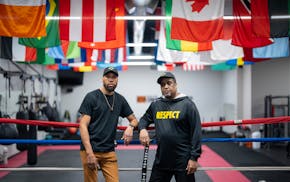When finishing a high school cross-country race, some exhausted runners will collapse on the ground and wait for a helping hand to pull them to their feet. Others throw their hands on their heads, breathing heavily, watching for teammates to cross the finish line.
Corey, instead, heads to her team tent, where she regroups with teammates. She is aware of the eyes that might be watching her. But negative reaction, for the most part, has been rare.
Corey is an average teen on the course — long brown hair, bracelets on her wrists. Her race bib blends into the crunch of runners.
"I've seen people stare at me while I'm running, or whisper to the person next to them, but that's nothing big," Corey said. "I can get over that."
Corey is one of Minnesota's transgender high school athletes, identified only by a nickname at her family's request. Athletes like Corey are the focus of a recent federal executive order that declared transgender athletes ineligible to play girls sports, preventing transgender girls and women from competing on sports teams that match their gender identity.
President Donald Trump signed the order on Feb. 5, with the order stating that transgender girls and women's participation in sports takes away the "safety, fairness, dignity and truth" of cisgender participants.
Upon being investigated by the Department of Education for its decade-old bylaw allowing transgender students to compete on teams matching their gender identity, the Minnesota State High School League has stated that it is using a 60-day window to evaluate how to approach the new federal policy — a window that closes in mid-April.
MSHSL officials and Minnesota Attorney General Keith Ellison have said the federal order conflicts with Minnesota's Human Rights Act and the state's constitution. Massachusetts, Maine and California have attracted similar attention from the Trump administration for their rules on high school athletes.
State bills to ban trans athletes from girls and women's sports have been proposed this winter by conservative legislators in the Minnesota House and Senate, though neither passed.
The MSHSL states that it does not collect data on how many transgender athletes compete in high school sports, or where, for data privacy reasons. A 2023 study from the Centers for Disease Control and Prevention estimated that 3.3% of high school students identify as transgender. In Minnesota, these students have lived through a decade of statewide policy that has enabled their participation in sports.
Now, they compete with the knowledge that this season could be their last.
Two transgender Minnesota high school students shared their stories and experiences in sports with the Minnesota Star Tribune.
A new team
After coming out to his parents in seventh grade, a swimmer in a metro suburb made the switch from his school's girls swim team to the boys swim team as a freshman.
"My parents just put me into swim lessons because they just wanted me to have basic swimming knowledge," said the swimmer, whom the Minnesota Star Tribune is not identifying at his family's request. "When I wanted to actually join a sport to stay active, I chose swimming because I really hated sweating."
The swimmer found his teammates and coaches, many of whom he knew from club swim, to be supportive of his transition. He attributed this to the progressive nature of his school and an inclusive culture fostered by the team's coaches.
"I was a little bit shocked," he said. "They care, but they don't care. I know that if something bad happened, they would be on my side. They don't make a big deal about that. They just see me as [me]."
He is a captain on his swim team, and his coach said he's one to give pep talks, offer car rides and lead dry land morning practices.
"People rely on him," said his coach. "He's a hardworking kid who just wants to swim fast and wants to feel included in the group, [which] wasn't that hard to do. He just seemed like one of the guys."
The coach spoke of other teams' coaches being accommodating and eager to help, sharing examples such as providing a family locker room for the swimmer and asking for feedback on their own swimmers' behavior.
"I've even had a couple coaches say to me, 'Let me know if any of my guys do or say anything,' " the coach said.
Corey, who took after her siblings when she started running, made the switch from her southeast Minnesota high school's boys team to its girls team in her sophomore year. She wears girls shoes and the girls uniform and spends time with teammates when she's not taking dual enrollment classes or working her part-time job.
"It's much nicer running on the girls team, just because it feels much more like I'm in the right place," she said.
Both Corey and the swimmer described having initial anxiety after switching teams, worried about facing scrutiny over their participation. For the swimmer, it was twofold: stress about his performance in the pool, but also stress about standing out in front of spectators.
"I would get so nervous, I would make myself sick, almost," he said. "I would miss, like, two out of my four races."
But both families said that, overall, their coaches and teams have been accepting. If there is any negative reaction — usually a pointed comment or question, or someone in the next lane over telling the swimmer they're surprised he beat them — it typically comes from an adult not connected to the transgender athletes' teams.
"Our biggest concern … was more the adults than the kids, to be honest," said the swimmer's mother. "One of the things we did was to join the booster club, just to be involved and seen. When you're involved, they're less likely to maybe say ugly things."
'Be good humans'
The school district where Corey runs cross-country and track requires school-affiliated coaches to seek district approval to speak with media, and this district barred Corey's coach from talking to the Minnesota Star Tribune last month. The district declined to give a reason.
But Corey also competes in club sports. One of her now-retired club coaches said when Corey joined their girls team, he met with her parents first. Then, in a coaches' meeting with the team, he disclosed that they would have a transgender athlete on the team that season.
"If you guys have issues with that, come and talk to me privately, and we will talk it out," he told them. At a race, the coach had a conversation that lasted an hour with a coach from another team who questioned Corey's participation.
"It came down to the point where I'm like, either you're on board with it and you're OK with it, or you're not. … We're trying to promote the sport, we're trying to teach kids to be good humans," Corey's coach said. "It's within the rules."
Those interviewed — parents, athletes and coaches — said transgender athletes' level of success can change how they're perceived. Nationally, the most high-profile cases of transgender athletes have come when they — or their team — are successful. Trump's order states that allowing transgender female athletes to compete in girls and women's sports "ignor[es] fundamental biological truths between the two sexes," regardless of if athletes medically transition.
"That's a much more difficult conversation to have," Corey's coach said.
Neither Corey nor the metro swimmer are among the state's elite athletes. Neither qualified for state-level competitions in their sports.
"You're not going to be a Division I athlete," the swimmer's dad said of his son. "It's high school sports, and it's about participating, being accepted."
Corey's parents had a discussion with her cross-country coaches about what to do if she ran fast enough to qualify for one of the team's varsity spots for a given week. Her mom and dad wanted to see their daughter do well, of course, but also worried that could draw more attention.
Corey ended up running in a couple of varsity races but mostly competed in junior varsity races. She also practices with the long distance group on her school's track team but has not yet competed this season, which began last month.
"I had that worry for a year, and most of the second year, actually, too," Corey said, agreeing with her mom. "I felt like I shouldn't run my best because then people might see me as too fast and that I take the top spots away from someone else.
"But then I realized I'm not actually that great," she added. "If I run my best I still do, like, just kind of mediocre."
What could change
Since becoming the first state to pass a law explicitly banning anti-trans discrimination in 1993, Minnesota has been viewed as one of the country's more trans-inclusive states. But the uncertainty over how federal policy may affect LGBTQ-related protections has transgender athletes and their families wondering how life might change for them — and not just in the pool or on the track.
"We know people who have moved here specifically for their [transgender] kids," Corey's mom said.
Postelection, the swimmer has been considering going to college in Canada to avoid the changing policies from the Trump administration — which extend beyond sports, such as limiting access to gender-affirming medical care.
"Is [moving] going to be the first thing that we do?" the swimmer's dad said. "No, but is it in our head? Yeah."
When asked what these athletes would do if Minnesota's bylaws changed, families and coaches had few answers. For the swimmer, there is the possibility that changes would affect only girls sports, but his family acknowledged that "undoubtedly" the climate at large would change.
Leaving sports entirely would mean leaving behind the benefits that both athletes rattled off: a daily routine, friendships, physical health, a community — everything from a distraction from scrolling on Instagram to a "space of belonging," said Corey.
Transgender high schoolers report higher levels of bullying and persistent sadness than their cisgender classmates, according to the CDC. Corey's mom went as far as to call sports "life-saving."
"[Sports] are a thing that can tie you to other people and build relationships and friends," the swimmer's coach said. "It's one of the reasons to live."
Corey's future in sports will be decided in the coming days. As the debate about trans athletes and fairness rolls on across the country, a small number of Minnesotans are watching closely.
"Any organization that does anything with youth sports, there are quite a few rules that you have to follow and abide by," Corey's former club coach said, "and unfortunately, some of those are dictated by the Legislature."
For now, those close to transgender athletes in Minnesota await further action from the state high school league and the federal government.
In the meantime, the athletes keep practicing, unsure of what comes next.

Minnesota sports stars reflect on George Floyd's legacy

Analysis: Strong May has Minnesota United set up for success in second half of season

Five things to watch for ahead of a critical Wolves vs. Thunder Game 3

Reusse: From the lovable land Down Under, Ingles serves as statesman for Timberwolves

